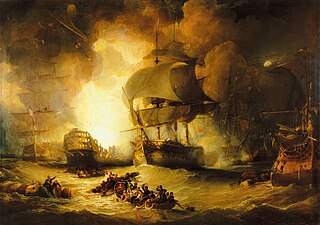
The Battle of the Nile was a major naval battle fought between the British Royal Navy and the Navy of the French Republic at Aboukir Bay on the Mediterranean coast off the Nile Delta of Egypt from the 1st to the 3rd of August 1798. The battle was the climax of a naval campaign that had raged across the Mediterranean during the previous three months, as a large French convoy sailed from Toulon to Alexandria carrying an expeditionary force under General Napoleon Bonaparte. The British fleet was led in the battle by Rear-Admiral Sir Horatio Nelson; they decisively defeated the French under Vice-Admiral François-Paul Brueys d'Aigalliers.

Abu Qir, formerly also spelled Abukir or Aboukir, is a town on the Mediterranean coast of Egypt, near the ruins of ancient Canopus and 23 kilometers (14 mi) northeast of Alexandria by rail. It is located on Abu Qir Peninsula, with Abu Qir Bay to the east.

The Cressy-class cruiser was a class of six armoured cruisers built for the Royal Navy around 1900. Their design's incorporation of a pair of 9.2-inch guns and armoured sides served to address criticism directed against the previous Diadem class — advances made possible by their 1,000 ton increase in displacement over their predecessors. The ships were notably stable, except for a susceptibility to pitching.
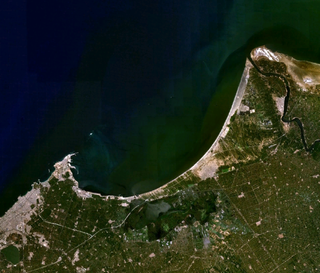
The Abū Qīr Bay is a spacious bay on the Mediterranean Sea near Alexandria in Egypt, lying between the Rosetta mouth of the Nile and the town of Abu Qir. The ancient cities of Canopus, Heracleion and Menouthis lie submerged beneath the waters of the bay. In 1798 it was the site of the Battle of the Nile, a naval battle fought between the British Royal Navy and the navy of the French First Republic. The bay contains a natural gas field, discovered in the 1970s.
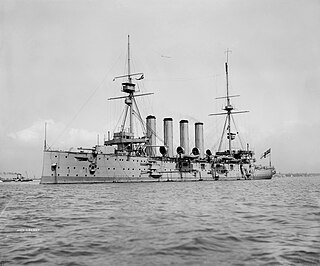
HMS Cressy was a Cressy-class armoured cruiser built for the Royal Navy around 1900. Upon completion she was assigned to the China Station. In 1907 she was transferred to the North America and West Indies Station before being placed in reserve in 1909. Recommissioned at the start of World War I, she played a minor role in the Battle of Heligoland Bight a few weeks after the beginning of the war. Cressy and two of her sister ships were torpedoed and sunk by the German submarine U-9 on 22 September 1914 with the loss of 560 of her crew.

HMS Aboukir was a Cressy-class armoured cruiser built for the Royal Navy around 1900. Upon completion she was assigned to the Mediterranean Fleet and spent most of her career there. Upon returning home in 1912, she was placed in reserve. Recommissioned at the start of the First World War, she played a minor role in the Battle of Heligoland Bight a few weeks after the beginning of the war. Aboukir was sunk by the German submarine U-9, together with two of her sister ships, on 22 September 1914; 527 men of her complement died.
Four ships of the Royal Navy have borne the name HMS Aboukir, after Abu Qir Bay, the site of the Battle of the Nile:
Vice Admiral Charles Frederick Schomberg, was an officer of the British Royal Navy. He was the eldest son of Admiral Alexander Wilmot Schomberg by his second marriage.
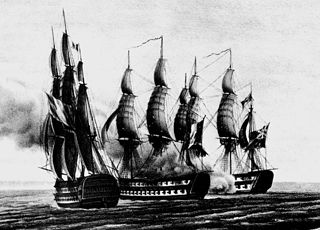
HMS Swiftsure was a 74-gun third rate ship of the line of the British Royal Navy. She spent most of her career serving with the British, except for a brief period when she was captured by the French during the Napoleonic Wars in the action of 24 June 1801. She fought in several of the most famous engagements of the French Revolutionary and Napoleonic Wars, fighting for the British at the Battle of the Nile, and the French at the Battle of Trafalgar.

The 7th Cruiser Squadron was a blockading force of the Royal Navy during the First World War used to close the English Channel to German traffic. It was employed patrolling an area of the North Sea known as the Broad Fourteens in support of vessels guarding the northern entrance to the Channel. The Squadron had been part of the Third Fleet of the Home Fleets.

HMS Aboukir was a 74-gun third-rate ship of the line of the Royal Navy, launched on 18 November 1807 at Frindsbury.
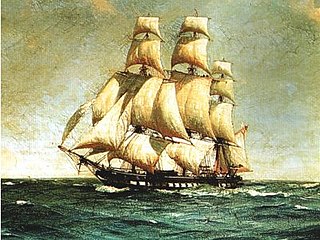
The Magicienne class was a class of twelve fifth rate 32-gun frigates of the French Navy, each with a main battery of 26 x 12-pounder long guns, and with 6 x 6-pounder guns on the quarterdeck and forecastle. They were designed by Joseph-Marie-Blaise Coulomb.

Aquilon was a Téméraire-class 74-gun ship of the line of the French Navy.

The Action of 22 September 1914 was an attack by the German U-boat U-9 that took place during the First World War. Three obsolete Royal Navy cruisers, of the 7th Cruiser Squadron, manned mainly by Royal Naval Reserve part-time reservists and sometimes referred to as the Live Bait Squadron, were sunk by U-9 while patrolling the southern North Sea.
Wenman Humfrey "Kit" Wykeham-Musgrave (1899–1989) was a Royal Navy officer who has the possibly unique distinction of having survived being torpedoed on three different ships on the same day.
The French brig Alerte was launched in April 1787. The Royal Navy captured her at Toulon in August 1793, and renamed her HMS Vigilante. The British set her on fire when they evacuated Toulon in December of that year. After the French rebuilt her as Alerte, she served at the Battle of Aboukir Bay. The British recaptured her in June 1799 and took her into service as HMS Minorca. Minorca was sold in 1802.
HMS Janissary or Janizary was a gun-boat that served in the Royal Navy's Egyptian campaign. She appears in the records only in connection with the campaign and her origins before 1800 or service after 1801 are lost. Her name honours the Janissaries, a body of Ottoman troops.
HMS Negresse was a tartane that the French Navy requisitioned at Marseilles in March 1798 and used as an aviso in the Egyptian campaign. The Royal Navy captured her in 1799 and took her into service. She participated in the defense at the siege of Acre later that year and in 1801 at the landing of British troops at Aboukir Bay. The Royal Navy sold her in 1802.
The action of 6 February 1799 was a minor naval action that took place during the French Revolutionary Wars off the island of Majorca between two Royal Navy ships and two Spanish naval frigates.
HMS Iphigenia was a 32–gun fifth rate frigate of the Royal Navy. She was launched in 1781, and served barely twenty years when she was accidentally lost in a fire at Alexandria in 1801.
This page is based on this
Wikipedia article Text is available under the
CC BY-SA 4.0 license; additional terms may apply.
Images, videos and audio are available under their respective licenses.














